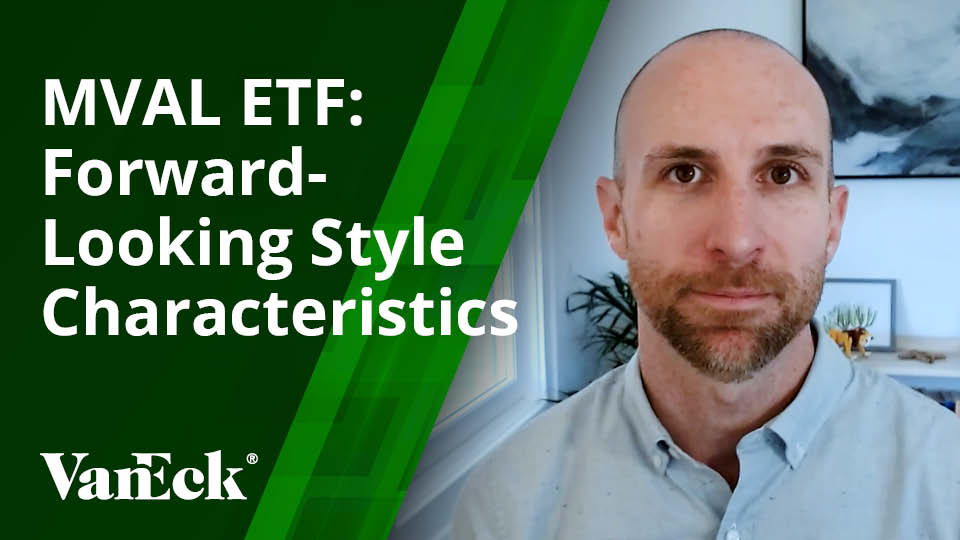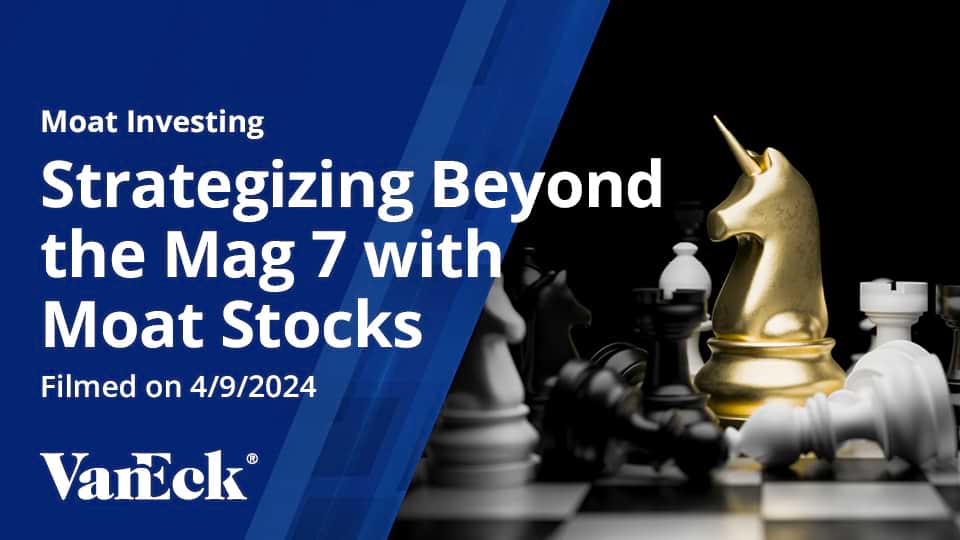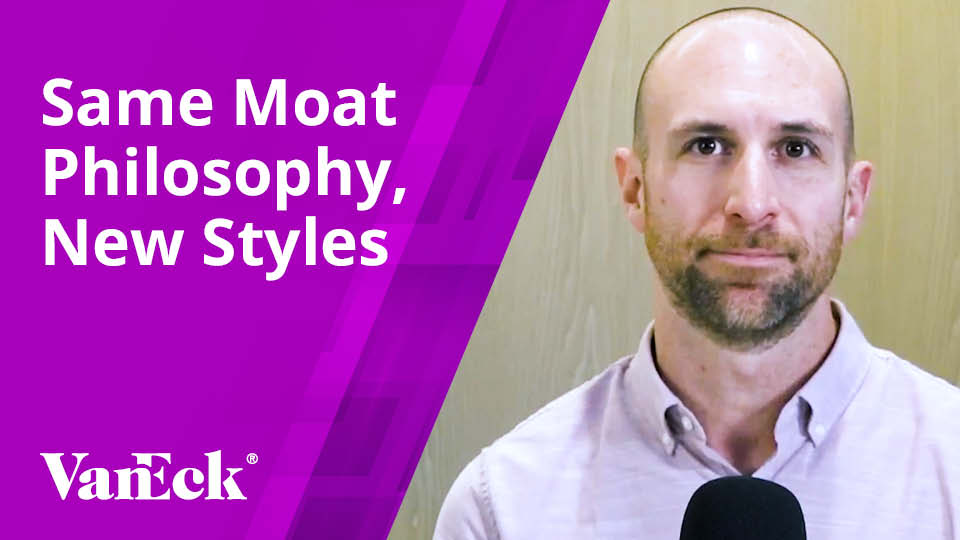The Morningstar Approach to Equity Research
February 28, 2019
Watch Time 6:38 MIN
Morningstar Head of Global Equity Research Elizabeth Collins discusses how Morningstar’s methodology has evolved with the markets over time and provides an overview of the single consistent process that all of its equity analysts follow.
The Morningstar Approach to Equity Research
ED LOPEZ: Hi, I'm Ed Lopez, Head of ETF Product at VanEck, I'm here today with Elizabeth Collins, Head of Global Equity Research at Morningstar and we're talking the Morningstar process around their moat methodology. Elizabeth, thanks for joining us today.
ELIZABETH COLLINS: Thanks so much for having me.
LOPEZ: Let's talk a little bit about your time at Morningstar and can you give us a little history about your experience with the Morningstar methodology and how it's evolved over time?
COLLINS: That's a really good question. I started at Morningstar 13 years ago as an analyst on the utilities and energy team. And then, after a while, I led the basic materials team. I was the chair of the economic moat committee for a while. I led the North American region and now I’m the head of global equity research. I would say, if I look over the course of these 13 years, what has really changed is, when I started in 2005, I would say that our research was very much bottom-up focused.
If you think about the most recent crises that had hit equity markets it was based on corporate scandals or financial shenanigans or in the tech sector, companies whose business models were not sustainable. So things like Enron and then internet companies that didn't have a lot of sustainability.
And I think because of that, Morningstar equity research at the time was rightfully focused on things like what the company’s business model is, and really scuttlebutt, getting to know the company, and what the competitive strengths and weaknesses were of individual companies. But over time obviously since then we've had the global financial crisis and also a lot of commodity price volatility and major swings that had actually significant changes over the years, later on in 2014 and 2015. I think because of those market movements we've necessarily become more top-down aware.
And not just bottom-up focused and I think that's a good ...that's been a good evolution for our department.
LOPEZ: Let me go back to when you started you said it was 2005, correct? How big was the Morningstar equity research team then and how much has it grown since then?
COLLINS: Well it's funny because our team is probably the same size it was, at least materially, so that it was when I started in 2005, except that at that time all of our analysts were focused in the U.S. and the Chicago headquarters. And I think that since then we've, at least on a proportionate basis, shrunk the relative importance of our Chicago office and expanded overseas in Asia, Europe, and Australia.
And I think that largely mimics what you've seen in markets in general in that there are much fewer publically traded companies today then there were say 10 or eight years ago.
LOPEZ: That makes sense. And how does that process work for analysts? Do you guys follow a specific process that every analyst has to follow? And how has that evolved over time?
COLLINS: We do have a very consistent process. Every analyst is working in a DCF model, a discounted cash flow model, in order to forecast their company’s earnings, power, and cash flows to arrive at a fair value estimate, or an intrinsic valuation. And then every analyst has to make a proposal for what they think a company's economic moat is. And they go through our committee in order to get that approved.
LOPEZ: What does that approval process look like when they go to the committee? How do they argue their case?
COLLINS: Well, first what an analyst will do is conduct their industry- and company-specific research. And let's say that the analyst is on the tech team. First, they'll throw their proposal in front of their tech team peers and that way the peers that have the greatest sector and industry knowledge and the ins and outs of the competitive dynamics of the tech sector will run that analyst through the gauntlet, so to speak. After the analyst gets through their own sector team, then they'll come to the global and cross-sector moat committee, where they have to argue for official approval of their moat rating process.
LOPEZ: And then, does the committee review that selection after the fact and review how good that pick was?
COLLINS: Well, it comes down to a vote. Although the moat committee itself has more than 15 members it's a rotating committee in terms of who's voting at any one moat committee meeting. And we do tend to look at what our moat ratings have meant over time with various white papers and research studies over the years.
LOPEZ: And so, with so many analysts that you have, it's over 100 analysts I think you have globally. Obviously, people are going to come and go. Do you feel like Morningstar has a process that someone could slot in and pick up that process and continue to deliver that consistent analysis?
COLLINS: That's a good question. I think it's actually another thing that has changed in the department since I joined it. When I joined it I would say that there were maybe two or three very strong personalities and leaders within the department that were the ultimate deciders of what any company's moat rating could be.
Now I think we have a process that is much more diffuse and, I guess for lack of a better word, democratic. Where we have more than 15 members of a global economic committee, with a variety of tenures and sector backgrounds. I think that gives us the benefit of diversity of thought when we have the analysts come through the moat committee and I think it makes our department more resilient. And that we have a process that will stand the test of time, as opposed to being beholden to any individuals.
LOPEZ: Elizabeth, thank you for joining me today.
COLLINS: It's been my pleasure.
LOPEZ: If you'd like to learn more about moat investing or additional insights from VanEck then visit VanEck.com/subscribe.
IMPORTANT DISCLOSURE
Please note that Van Eck Securities Corporation (an affiliated broker-dealer of Van Eck Associates Corporation) may offer investments products that invest in the asset class(es) or industries included in this video. For more information on moat investing, please visit www.vaneck.com/moat-investing.
This is not an offer to buy or sell, or a solicitation of any offer to buy or sell any of the securities mentioned herein. The information presented does not involve the rendering of personalized investment, financial, legal, or tax advice. Certain statements contained herein may constitute projections, forecasts and other forward looking statements, which do not reflect actual results, are valid as of the date of this communication and subject to change without notice. Information provided by third party sources are believed to be reliable and have not been independently verified for accuracy or completeness and cannot be guaranteed. The information herein represents the opinion of the author(s), but not necessarily those of VanEck.
Fair value estimate: The Morningstar analyst's estimate of what a stock is worth.
Price/Fair Value: ratio of a stock's trading price to its fair value estimate.
Discounted cash flow (DCF) is a valuation method used to estimate the value of an investment based on its future cash flows.
The Morningstar® Wide Moat Focus IndexSM, Morningstar® Global ex-US Moat Focus IndexSM, and Morningstar® Global Wide Moat Focus IndexSM were created and are maintained by Morningstar, Inc. Morningstar, Inc. does not sponsor, endorse, issue, sell, or promote the VanEck Vectors Morningstar Wide Moat ETF, VanEck Vectors Morningstar International Moat ETF, or VanEck Vectors Morningstar Global Wide Moat ETF and bears no liability with respect to the ETFs or any security. Morningstar® is a registered trademark of Morningstar, Inc. Morningstar Wide Moat Focus Index, Morningstar Global ex-US Moat Focus Index, and Morningstar Global Wide Moat Focus Index are service marks of Morningstar, Inc.
Morningstar Wide Moat Focus Index consists of U.S. companies identified as having sustainable, competitive advantages and whose stocks are the most attractively priced, according to Morningstar. Morningstar Global ex-US Moat Focus Index consists of international companies identified as having sustainable, competitive advantages and whose stocks are attractively priced.
There are inherent risks with equity investing. These risks include, but are not limited to stock market, manager, or investment style. Stock markets tend to move in cycles, with periods of rising prices and periods of falling prices.
Investing involves substantial risk and high volatility, including possible loss of principal. An investor should consider a Fund’s investment objective, risks, charges and expenses carefully before investing. To obtain a prospectus and summary prospectus for VanEck Funds and VanEck Vectors ETFs, which contain this and other information, call 800.826.2333 or visit vaneck.com. Please read the prospectus and summary prospectus for VanEck Funds and VanEck Vectors ETFs carefully before investing.
Van Eck Securities Corporation, Distributor
666 Third Avenue, New York, NY 10017
Related Topics
Related Insights
April 10, 2024


